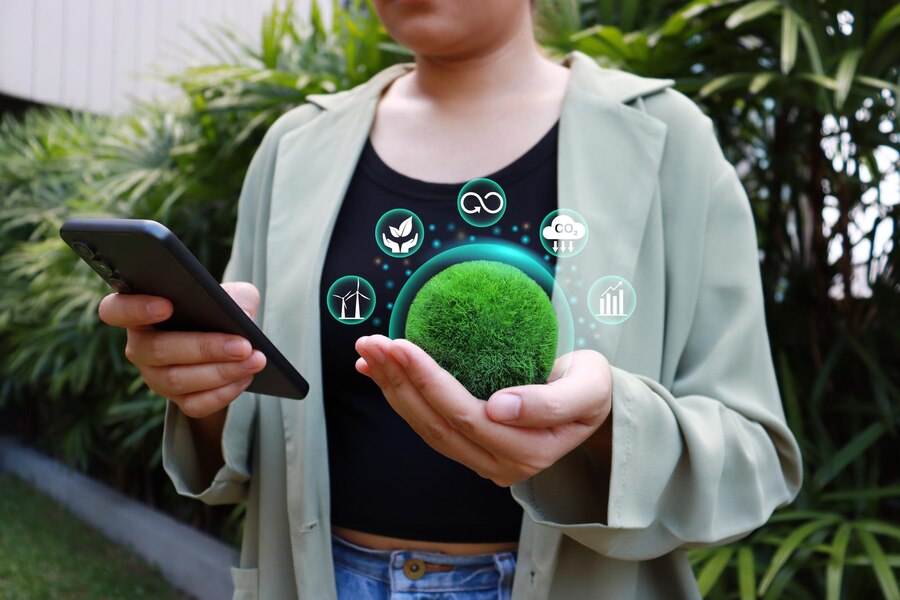
Overview
Innovative digital solutions have become essential in tackling environmental sustainability concerns in an era of fast technology innovation. Technology is essential to creating a more sustainable future, from cutting carbon emissions to protecting natural resources. This article examines a number of cutting-edge technological solutions that are promoting progress in a variety of fields and businesses. We will explore renewable energy sources, IoT applications, smart grids, artificial intelligence (AI) for resource management, and much more. Every answer is supported by pertinent sources, statistics, and real-world examples.
1. Intelligent Grids
The next generation of electrical grid technology, known as “smart grids,” combines automation, monitoring, and sophisticated digital communication to increase dependability and efficiency. They make it possible to optimize resource utilization, reduce waste, and better manage the supply and demand for energy. The International Energy Agency (IEA) claims that by optimizing distribution and consumption patterns, smart grids can cut the world’s energy usage by as much as 10% (IEA Report). According to the US Department of Energy, smart grid technology has allowed utilities in the US to avert up to 85% of outages through real-time monitoring and rapid response capabilities.
Benefits
- minimizes energy waste.
- increases grid stability.
- enhances the integration of renewable energy.
Challenges:
- high costs of the first investment.
- issues with cybersecurity.
2. Using Artificial Intelligence (AI) to Manage Resources
From forecasting resource availability to improving waste management procedures, artificial intelligence is being utilized more and more to optimize resource management. Algorithms that use machine learning can predict water use, increase agricultural yields, and better control waste. AI has the potential to increase resource efficiency in agriculture alone by up to 20%, according to the World Economic Forum. AI helps reduce landfill waste in the circular economy by improving material sorting and recycling (Ellen MacArthur Foundation).
Uses:
- water management using predictive analytics.
- AI in farming to cut down on fertilizer use.
- improved recycling and garbage sorting.
Real-World Illustration:
- AI is being used by IBM’s Project Debater to assist towns in making better waste management decisions.
3. Sources of Renewable Energy
At the forefront of technical advancements meant to lessen their impact on the environment has been renewable energy. In addition to being more cost-effective, solar, wind, hydro, and geothermal energy are also cleaner options. Because of their ability to supply sustainable energy for everyone, the International Renewable Energy Agency (IRENA) projects that by 2050, 86% of the world’s electricity generation capacity will come from renewable energy sources. For example, solar power has become a mainstream energy alternative due to its huge cost reductions and better efficiency (Solar Energy Industries Association).
Renewable Energy Types:
- Solar Power: By converting sunlight into electrical power, panels help to lessen reliance on fossil fuels.
- Wind Power: Produces electricity by using wind turbines.
- Using the force of rushing water, hydropower generates energy.
- Geothermal: Produces electricity by harnessing the earth’s heat.
4. Environmental Monitoring with the Internet of Things (IoT)
Real-time monitoring of environmental factors including soil health, wildlife behaviors, and air and water quality is made possible by IoT technology, which links sensors and equipment to the internet. Cities and communities can use the data to monitor pollution sources, manage resources effectively, and react quickly to environmental hazards (National Geographic). For instance, IoT-enabled smart garbage containers optimize trash collection routes, lowering vehicle emissions (Nestlé).
Uses:
- observing the quality of the water and air.
- monitoring the movement of wildlife.
- maximizing the gathering of garbage.
Benefits
- collecting data in real time.
- better judgment.
- increased consciousness of the environment.
5. Supply Chain Transparency Using Blockchain Technology
Beyond cryptocurrencies, blockchain technology is revolutionizing supply chain transparency, which is essential for sustainable growth. Blockchain is capable of tracking a product’s whole lifecycle, from raw ingredients to disposal, by offering an unchangeable and transparent ledger. This makes things more ecologically friendly and ethically sourced. By verifying the sustainability of items, blockchain can help stop greenwashing, according to the Ellen MacArthur Foundation. For instance, IBM’s Food Trust blockchain tracks food’s path from farm to table to make sure it complies with sustainability guidelines (IBM Food Trust).
Benefits
- increases the visibility of the supply chain.
- lowers waste and fraud.
- encourages the use of ethical sources.
Challenges:
- method that uses a lot of energy.
- Regulatory issues.
Questions and Answers (FAQs)
What are smart grids’ primary advantages?
Smart grids facilitate greater integration of renewable energy sources, increase system stability, and improve energy efficiency.
In what ways does artificial intelligence support environmental sustainability?
AI helps cities make data-driven decisions to improve sustainability, minimize waste, and optimize resource management.
Which renewable energy sources show the greatest promise?
Geothermal, hydropower, wind, and solar are all viable renewable energy sources, each with unique benefits and drawbacks.
Can trash management be aided by IoT?
Indeed, IoT can track unlawful garbage disposal, optimize waste pickup routes, and monitor landfill sites.
How does blockchain affect the transparency of the supply chain?
An immutable record provided by blockchain ensures that items meet sustainability criteria by tracking them from raw ingredients to disposal.
In conclusion
The goal of innovative tech solutions is to build a sustainable future, not only increase operational efficiency. Every technology, from AI that forecasts resource availability to smart grids that optimize energy use, is essential to lessening the impact on the environment. Achieving global sustainability targets will depend on how well these technologies are incorporated into daily operations. To fully realize the potential of these creative solutions for a greener world, more research and development funding as well as international collaboration will be required.